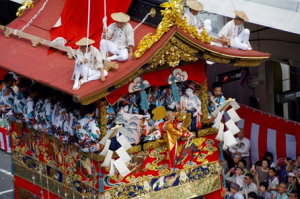Music is medicine, and metallic sounds are sounds used since ancient times to communicate with the heavens? ! <1> ~What are the mysterious medicinal properties of Kyoto?
Yoshie Doi

Photographed on July 17, 2014
Do you know the proverb from the end of the Edo period that goes, “I’d rather take a nap in Kyoto than study in the countryside?” This is a proverb that has been passed down from generation to generation to express the greatness of Kyoto during the Edo period. To put it bluntly, it’s been three days of naps in Kyoto compared to three years in the countryside. Originally, it meant, “People born in the capital are somehow pure and superior to people who studied and studied in the countryside.”
Norinaga Motoori became a first-class scholar by absorbing the culture through his skin just by staying in the capital of Kyoto during the Edo period, which was full of authentic things. From the age of 23 to 28, he wrote about his time studying in Kyoto in his “Kyoto Diary.”
It is said that he spent his days touring shrines and temples almost every day and drinking heavily, but it is said that he became a great scholar as a result of coming into contact with authentic culture. Perhaps because he was exposed to the real thing, he was able to acquire the sensibility to discern. Culture can also be felt through the skin.
Kyoto, which has served as the capital for 1074 years since the Heian period, has also been a source of culture, giving form to invisible culture. Music cannot be seen with the eyes, but it can be heard with the ears.
I start my day every morning by listening to music. I’m preparing breakfast while listening to Kitaro’s Silk Road. I met Kitaro several times at concerts at Kyoto University’s Hanayama Observatory, and we also spoke at a party afterwards. Since then, I’ve become a huge fan of Kitaro, and through his music I’ve started to realize that I’m alive in the universe.
Mr. Kitaro says, “I am inspired by the natural world. For me, some songs are clouds, others are water.” “Music allows me to experience the whole world.”
In Yasunari Kawabata’s “Koto,” there is a scene in which the estranged twins Chieko and Naeko meet at an inn in Yoiyama during the Gion Festival. Music is also depicted there.
The music for the Gion Festival is called konkon tikichin, and is made up of three types of ensembles: gongs, taiko drums, and flutes.
It is mentioned in the “Sandaime Jitsuroku” that music was played during a spiritual gathering at Shinsenen in 863, the fifth year of the Jogan era (863) during the Heian period. The picture also says, “This is called Gion Hayashi, which is played with a flute, gong, and drum.” The reason why Gion Hayashi plays the role of requieming the souls of evil spirits is probably due to this Gion Hayashi. Music is an integral part of festivals, and it is said that in ancient times metal sounds were used to communicate with the heavens. The New Year’s Eve bell is also a metallic sound, and the frequency seems to vary depending on the temple. For some reason, the sound of gongs and bells resonates in the soul.
Jiro Osaragi’s “The Temptation of Kyoto,” which is introduced in “The Ancient Capital,” is out of print, but it says, “The cedar plantations that made Kitayama logs piled up with blue tops like stratus clouds, and the red pine trees The whole mountain, whose trunks are lined up delicately and brightly, sends out the singing voices of the trees like music…”, which I felt was a deep consideration of the sounds of Kyoto.
When I visited the mansion in Arashiyama where Yasunari Kawabata wrote “The Sound of the Mountain” late at night, I had the experience of hearing the sounds of the mountains and the river. The quiet space seems to have the sounds of nature and the sounds of Kyoto, which is an eternal topic of exploration.
The end of document
Translated by Masami Otani
